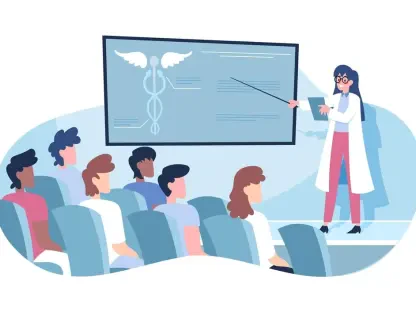Overview of the H-1B Visa Program and Healthcare Challenges
Imagine a rural hospital struggling to keep its doors open, with patients waiting weeks for critical care due to a lack of physicians, a scenario becoming all too common across the United States as the healthcare industry grapples with severe workforce shortages. The H-1B visa program, a cornerstone for attracting skilled foreign talent, has been instrumental in filling these gaps by enabling international medical graduates (IMGs) to practice in underserved areas. However, a recent policy shift introducing a staggering $100,000 fee per H-1B petition, announced on September 19, has raised alarms among healthcare providers. This fee hike threatens to disrupt the pipeline of essential medical professionals at a time when demand for care is soaring.
The current state of the healthcare workforce paints a grim picture, with shortages particularly acute in rural and underserved regions. Hospitals and clinics often rely on IMGs, who account for roughly 25% of practicing physicians nationwide, to bridge these gaps. With an aging population and insufficient growth in the domestic medical workforce, the dependency on foreign-trained talent has never been more critical. The new fee structure could exacerbate existing challenges, potentially pricing out many healthcare facilities from recruiting the talent they desperately need.
This development comes against the backdrop of broader immigration policy changes, raising questions about balancing national interests with public health priorities. The financial burden imposed by the fee increase could deter smaller hospitals, especially those in economically strained areas, from hiring IMGs. As the industry navigates these turbulent waters, the implications for patient care and access to services are profound, setting the stage for a deeper examination of this pressing issue.
The Vital Role of International Medical Graduates in U.S. Healthcare
Contributions and Impact of IMGs
International medical graduates play an indispensable role in sustaining the U.S. healthcare system, particularly in regions where local talent is scarce. As of recent data, about 64% of foreign-trained physicians serve in medically underserved or health professional shortage areas, providing care where it is needed most. Their presence ensures that communities with limited resources are not left without essential medical services, often stepping in to handle caseloads that would otherwise overwhelm local systems.
Statistics further underscore their importance, with nearly 17,000 H-1B visas issued to health and medical professionals last year, representing 4.2% of total petitions. These professionals, including physicians and surgeons, fill critical positions without displacing American workers, as their roles often target specialties and locations with persistent vacancies. This dynamic highlights how IMGs complement rather than compete with the domestic workforce, addressing systemic gaps in care delivery.
Their contributions extend beyond mere numbers, often bringing diverse perspectives and specialized training that enrich the medical field. Many IMGs commit to long-term service in challenging environments as a condition of their visa programs, ensuring stability in areas prone to high turnover. This dedication is a lifeline for countless patients who might otherwise face significant barriers to accessing healthcare.
Physician Shortages and Demographic Pressures
Looking ahead, the U.S. faces a daunting physician shortage projected to reach 86,000 by 2036, driven by an aging population and rising demand for healthcare services. The growth in domestic medical training programs has not kept pace with these needs, leaving a void that foreign talent has historically filled. As baby boomers enter their later years, the strain on the system is expected to intensify, particularly in specialties like geriatrics and primary care.
Demographic trends also reveal an increasing reliance on IMGs to meet future demands. With rural areas already struggling to attract physicians, the absence of international professionals could lead to critical service disruptions. Forecasts suggest that without sustained access to global talent, many communities will face longer wait times and reduced quality of care, amplifying existing inequities in healthcare access.
This looming crisis underscores the urgency of maintaining a robust pipeline of international medical professionals. Policy decisions made today will shape the landscape of healthcare delivery for decades, making it imperative to consider the long-term implications of restricting access to H-1B visas for this vital workforce segment.
Financial and Operational Impacts of H-1B Fee Increases
The introduction of a $100,000 fee per H-1B visa petition presents a significant financial hurdle for hospitals and healthcare providers, many of whom operate on tight budgets. For smaller facilities, particularly in rural settings, this cost could be prohibitive, effectively blocking their ability to recruit much-needed international talent. The expense adds a layer of complexity to already strained financial models, forcing administrators to weigh patient care needs against fiscal constraints.
Operationally, the fee hike threatens to disrupt the talent pipeline that sustains critical healthcare services. Recruiting IMGs often involves lengthy processes, and the added cost could deter facilities from initiating or continuing such efforts. This disruption risks creating staffing shortages at a time when patient volumes are increasing, potentially leading to burnout among existing personnel and compromising care quality.
Industry leaders, such as AHA President and CEO Rick Pollack, have voiced deep concerns about the ripple effects on underserved communities. They argue that the policy could widen disparities in access to care, as rural hospitals may be forced to scale back services or close altogether. Proposed solutions include targeted exemptions for healthcare workers or alternative funding mechanisms to alleviate the burden, ensuring that patient needs remain the priority amidst policy shifts.
Regulatory Framework and Advocacy by Medical Organizations
The regulatory landscape surrounding H-1B visas reflects broader immigration policy objectives aimed at controlling foreign labor influx while protecting domestic interests. The rationale behind the substantial fee increase ties into efforts to fund border security and deter over-reliance on international workers. However, this approach has sparked debate about its unintended consequences for sectors like healthcare, where foreign talent addresses critical shortages rather than competes with local labor.
In response, over 50 medical organizations, including the American Medical Association and the American Hospital Association, have united in opposition, submitting letters to the Department of Homeland Security. Their advocacy emphasizes the unique role of healthcare workers in sustaining public health, arguing that the fee hike jeopardizes patient care and workforce stability. They call for specific exemptions to shield the industry from financial strain that could cascade into broader access issues.
These groups present a compelling case, focusing on the intersection of immigration control and public health needs. Their arguments highlight that healthcare is not merely an economic sector but a fundamental societal necessity, deserving of tailored policy considerations. Balancing these competing priorities remains a challenge for regulators, as they navigate the tension between stringent immigration measures and the urgent demands of a strained healthcare system.
Long-Term Implications for Healthcare Access and Policy
If the H-1B fee increase remains unchanged, the long-term effects on healthcare access could be severe, particularly for vulnerable populations in rural and underserved areas. The potential reduction in IMG recruitment might lead to unfilled positions, longer patient wait times, and diminished service capacity in regions already struggling with provider scarcity. Such outcomes would deepen existing disparities, leaving entire communities with limited options for medical care.
Emerging challenges include the exacerbation of labor shortages and increased pressure on current staff, who may face higher workloads and burnout risks. Without policy adjustments, hospitals could see a domino effect, where reduced staffing compromises patient outcomes and strains operational resilience. This scenario is particularly concerning given the global competition for medical talent, as other nations offer more favorable immigration pathways to attract skilled professionals.
The broader implications of immigration policy on healthcare delivery also warrant attention, especially as demographic shifts and aging populations drive demand. Innovative solutions, such as streamlined visa processes or federal subsidies for H-1B fees in critical sectors, could help mitigate these risks. Policymakers must prioritize sustainable workforce strategies to ensure that the U.S. remains competitive in attracting and retaining the global talent necessary for a robust healthcare system.
Final Reflections and Path Forward
Reflecting on the discussions held, the critical dependency of the U.S. healthcare system on international medical graduates becomes evident as a lifeline for countless communities. The unified opposition from medical lobbies underscores the gravity of the $100,000 H-1B fee hike, which poses a tangible threat to patient care and workforce sustainability. Data highlighting the projected physician shortage and the significant presence of IMGs in underserved areas lends undeniable weight to the argument for policy reconsideration.
Looking ahead, actionable steps emerge as a priority to address this challenge. Exemptions for healthcare workers from the fee increase stand out as an immediate solution to safeguard access to care, while broader dialogue with policymakers offers a pathway to explore long-term reforms. Collaborative efforts to develop alternative funding models or visa incentives for critical sectors also surface as potential mechanisms to balance immigration objectives with public health imperatives.
Ultimately, the resolution of this issue demands a commitment to innovative thinking and cross-sector partnership. By prioritizing patient needs and fostering policies that support a diverse medical workforce, stakeholders can mitigate the risks of disruption. This focus on adaptability and strategic planning promises to guide the healthcare industry through the uncertainties of evolving immigration frameworks, ensuring that care delivery remains uninterrupted for those who need it most.









